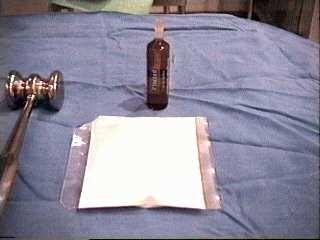PRESENTATION
The packing of surgical use radio-opaque
Simplex®P cement includes two sterile components.
One of the composants is a flask
containing 20 ml of a colourless monomer, a flammable liquid with a slightly
sweetened bitter odour, composed of :
Methyl methacrylate (monomeric),
19.5ml N N-dimethyl para toluidine, 0. 5ml Hydroquinone, USP 1.5mg.
Hydroquinone is added to prevent
premature polymerization which can occur under certain conditions - ex
: exposure to the light, high temperatures.
N N - dimethyl para toluidine is
added to enhance the hardening of the therapeutic finished compound.
The liquid component is sterilized
by membrane filtration.
The other composant is a sachet containing
g of finely divided powder made up of the following:
Methyl methacrylate - styrene
Copolymer 30.0 g
Polymethylmethacrylate 6.0g
Sulphate Barium pH Eur. 4.0g
The powder is sterilized by
gamma irradiation. The Barium Sulphate incorporated in surgical use radio-opaque
Simplex®P cement acts to provide a contrast during the radiological
examination.
However in my opinion, it is essential
to add tantalum or tungsten powder because the Barium sulphate is not opaque
enough. When it is used, the powder and the liquid are mixed together,
producing an exothermic reaction which results in a paste-like soft, flexible
polymer being produced. As the reaction progresses, a compound resembling
hard cement is formed, within a few minutes.

DOSING
For vertebroplasty 1 volume of
solvent is used for 4 volumes of powder.
PREPARATION
AND ADMINISTRATION
The liquid monomer, the flask and its
packing are pre- sterilized. The product must not be used if the packaging
is damaged. To mix, completely empty the sachet containing the powder into
a suitable, sterile inert mixer. Add all the liquid contained in the flask
to the powder. The liquid must be added to the powder and not the powder
to the liquid. Mix using a suitable inert device, stirring until the powder
is completely saturated with the liquid. For use with a syringe, mix thoroughly
for between 1 and 2.5 minutes. Introduce the liquid cement into a
suitable injection device, and inject into the bone.
CONTRA-INDICATIONS
The use of surgical use radio-opaque
Simplex®P cement is contra-indicated in patients allergic to one or
the other of its constituents. The use of the product is contra-indicated
in the event of infectious arthritis.

WARNINGS
AND PRECAUTIONS AND INTERACTIONS
The liquid monomer and the powder must
be meticulously mixed. The data drawn from in- vitro studies showed that
the widening out of the monomer is due mainly to the speed of the mixing
and secondly to the length of time the mixing takes. The end of the polymerization
process which occurs inside the patient's body is an exothermic reaction
causing a noticeable amount of heat to be released.
Temperatures recorded during polymerization
may rise to l10° Centigrade.
The extent of tissue damage caused
by the long-term effects of the heat is not known.
Particular precautions must be taken
in order to detect and to correct the transitory fall of the blood pressure
which can occur when the product is injected into the bone.
As the monomeric liquid is highly
volatile and flammable the operating theatre suite will have to be equipped
with adequate ventilation in order to eliminate a maximum quantity
of monomeric vapour.
Precautions will have to be taken
during the mixing of the two components in order to avoid excessive
exposure to the concentrated monomer vapour which can cause an irritation
of the respiratory tracts and eyes, and even of the liver. The liquid component
is an active lipidic solvent.
Predisposed subjects are likely to
suffer dermitis on contact. The wearing of a second pair of surgical
gloves and a strict adherence to the mixing instructions can decrease the
possibility of over-sensitive reactions. The compound should not
come into direct contact with sensitive tissue or be absorbed by
the body.
Because of the lack of appropriate
information, use of the product is not recommended in young patients.
The case of pregnant woman : although
the results of the study of animal teratology are negative, it is necessary
to weigh the benefits of the treatment against the possible dangers to
the mother and the foetus in the event of pregnancy or among women of child-bearing
age.

ADVERSE
EFFECT
The most significant undesirable reactions,
some with a fatal outcome, connected with the use of acrylic cement are
:
. heart failure,
. myocardial infarction,
. pulmonary embolism,
. cerebral vascular accidents.
The adverse effects which are the
most frequently reported are :
. a transitory drop in blood pressure.
. thrombophlebitis,
. haemorrhaging and haematoma.
SIGNIFICANT
MEDICAL INFORMATION
The adverse effects which affect the
cardiovascular system have been attributed to the widening of the monomeric
liquid loose in the circulatory system. Moreover more recent data
indicates that the monomer causes fast hydrolysis in methacrylic acid and
that a significant quantity of the circulating methacrylate is in the form
of free acid rather than the form of methyl ester.The correlation between
the changes in the concentrations of methacrylic acid and methyl methacrylate
circulating in the body and the variations in blood pressure was not established.
The deferred episodes of hypertension
occur rather more among patients whose blood pressure is high or higher
than the normal, in patients in hypovolemy, and the individuals with pre-existent
cardiovascular anomalies.
If a hypotensive reaction occurs,
this can begin 10 to 165 seconds after the application of the cement
and can last between 30 seconds and 5-6 minutes.
Although the etiology of the heart
failure is uncertain, it can be due to the direct effects of an embolism
or secondly to hypoxia produced by the phenomenon of pulmonary embolism.

PHARMACEUTICAL
PRECAUTIONS
Store in the dark and at temperatures
lower than 25°C.
Do not use this product after its
expiry date.
PRESENTATION
Unit box or box of 10 units - each unit
contains :
1 sterile sachet containing
40 G of sterile polymeric powder, 1 sterile flask containing 20 ml of sterile
monomeric liquid.
References : box of 10 units individual
box

|

